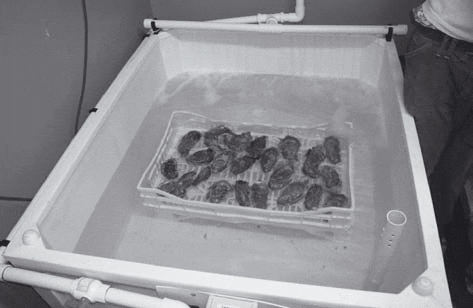Background
In the UK noroviruses causing gastroenteritis are the most common cause of problems. However, other microbiological agents may also occasionally be implicated. The microbiological quality of surface waters is generally assessed by monitoring of faecal indicators such as E. coli and Enterococcus but these micro organisms are found in high numbers in the faecal material from animals as well as birds, and do not provide information regarding the source of contamination. Despite legislative and practical efforts to reduce faecal contamination in shellfish waters, the problem persists throughout developed and less developed regions of the world.
Faecal contamination can originate from a wide variety of different sources, including point source sewage discharges, broken or cracked sewers and septic systems, overflowing storm drains, as well as run-off from agricultural land. Faecal material from wild animals and birds can also be a significant load in aquatic and marine environments. The myriad potential sources of faecal contamination in shellfish harvesting areas underline a need for sensitive, accurate and temporally and spatially robust methods to detect and apportion faecal inputs. There have been several recent reports of costly improvements to wastewater treatment facilities to improve the sanitary conditions of a shellfish harvesting areas, with little or no discernible improvements. In such cases it is important to understand the relative contributions of treated wastewater compared with other potential faecal sources such as agricultural run-off or wild birds.
By successfully identifying sources of faecal contamination remedial efforts can be more directly focused and targeted. Consequential improvements in water classifications will both improve the quality status of products, help safeguard against future tightening of food quality standards, and maximise the market opportunities for producers.. The science used to determine the source of faecal contamination encompasses molecular biology, microbiology, and chemistry and is termed Microbial Source Tracking (MST).
The MST ‘toolbox’
Most MST methods tend to be categorised into either ‘library dependent’ or ‘library independent’ approaches. Library dependent methods begin with the collection and characterization of a large number of bacteria from known sources (e.g. humans, cows, wildfowl). A given characteristic of these bacteria are subsequently analysed, and isolates from other sources compared and contrasted against this dataset. Library dependent studies have successfully used a variety of different genetic and biochemical characteristics to identify the source.
These include carbohydrate utilization, biochemical fingerprinting, antibiotic resistance profiling, ribotyping and pulsed field gel electrophoresis patterns. Conversely, library independent methods tend to focus on the identification of host-specific bacteria and/or viruses such as Bacteroides fragilis phages, coliphages, human/animal-specific viruses, or particular genotypic markers, such as coliphage genotyping. The use of chemical signatures that are considered source-specific to human faecal contamination have also been used with varying degrees of success, and include caffeine, detergents, whitening agents, sterols and degradation products from narcotics such as cocaine.
Urgent need for appropriate methods, and targets
A major stumbling block associated with many MST studies is the use of one approach coupled to a single marker to apportion faecal contamination. No single marker (biological or chemical) possesses all of the characteristics necessary to detect faecal contamination adequately, hence the recent tendency to use several targets simultaneously. Markers or indicators of faecal contamination, should ideally:
- Possess similar survival characteristics to faecal pathogens
- Be present in greater numbers than faecal pathogens
- Be specific to a particular faecal source or be identifiable to origin
- Correlate with health risk (i.e. norovirus, hepatitis A, Vibrio cholerae)
- Be readily identifiable/detected using molecular approaches
Many of the current MST methods do not adequately satisfy these criteria. In addition application of MST methods to molluscan shellfish is further complicated by the complex biology of these feed-feeding species. Currently the fate of commonly used MST indicators in association with shellfish is unknown, leading to significant problems in interpretation of results.
Development of MST capabilities at Cefas
Consequently, Cefas Weymouth has developed a range of MST approaches applicable to shellfish harvesting areas and shellfish matrices. Underpinning these MST approaches is the use of mitochondrial DNA (mtDNA), alongside bacterial indicator targets. The advantages of targeting mtDNA in this context are substantial:
- mtDNA is species specific.
- mtDNA contains many copies per cell, so can be detected easily using appropriate molecular methods such as PCR.
- Faecal material contains large numbers of exfoliated cells.
Using oyster samples challenged with pig, sheep, cow and human faecal material in depuration tanks (Fig. 1) it was possible to unambiguously identify sources of faecal contamination using real-time PCR assays developed at Cefas. To verify faecal contamination, probes targeting E. coli were also utilised, and this combination of eukaryote and prokayote targets can be combined effectively. Although studies in shellfish are at an early stage initial results have been promising. We hope that following further method development and validation these approaches will provide a suite of tools providing more effective identification of the potential sources of faecal contamination in shellfish harvesting areas.

Depuration tanks with Pacific Oyster grown in faecally amended seawater
Further Reading
| - | You can view the full Cefas Shellfish News publication by clicking here. |
Winter 2008




